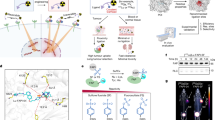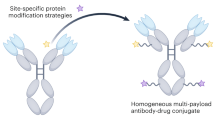Abstract
Doxorubicin intercalates into DNA, causes double-strand breaks, and leads to apoptotic death. Limitations to the efficacy and therapeutic index of doxorubicin include poor tumor selectivity, high systemic toxicity, and the development of resistance, especially p-glycoprotein (p-gp)-mediated. We chemically coupled doxorubicin to a monoclonal antibody directed to the insulin-like growth factor-1 receptor, a receptor highly overexpressed in most tumors and validated as a tumor target. The prodrug conjugate bounded to tumor cells selectively, and accumulated efficiently and only in receptor-expressing cells. The conjugate was processed to release free doxorubicin inside target cells leading to selective toxicity, had >200-fold improved therapeutic index, and in vivo reduced tumor load with no systemic toxicity. Importantly, the prodrug conjugate is not subject to p-gp efflux and can bypass resistance in vivo. Our studies define a strategy to develop improved and more selective anticancer agents.
This is a preview of subscription content, access via your institution
Access options
Subscribe to this journal
Receive 50 print issues and online access
$259.00 per year
only $5.18 per issue
Buy this article
- Purchase on Springer Link
- Instant access to full article PDF
Prices may be subject to local taxes which are calculated during checkout







Similar content being viewed by others
References
Adams TE, Epa VC, Garrett TP and Ward CW . (2000). Cell Mol. Life Sci., 57, 1050–1093.
Arap W, Pasqualini R and Ruoslahti E . (1998). Science, 279, 377–380.
Baserga R . (1999). Exp. Cell Res., 253, 1–6.
Berezov A, Chen J, Liu Q, Zhang HT, Greene MI and Murali R . (2002). J. Biol. Chem., 277, 28330–28339.
Berezov A, Zhang HT, Greene MI and Murali R . (2001). J. Med. Chem., 44, 2565–2574.
Casares S, Stan AC, Bona CA and Brumeanu TD . (2001). Nat. Biotechnol., 19, 142–147.
da Rocha AB, Lopes RM and Schwartsmann G . (2001). Curr. Opin. Pharmacol., 1, 364–369.
Fakata KL, Elmquist WF, Swanson SA, Vorce RL, Prince C and Stemmer PM . (1998). Life Sci., 62, 2441–2448.
Fritzer M, Szekeres T, Szuts V, Jarayam HN and Goldenberg H . (1996). Biochem. Pharmacol., 51, 489–493.
Garsky VM, Lumma PK, Feng DM, Wai J, Ramjit HG, Sardana MK, Oliff A, Jones RE, DeFeo-Jones D and Freidinger RM . (2001). J. Med. Chem., 44, 4216–4224.
Gottesman MM, Fojo T and Bates SE . (2002). Nat. Rev. Cancer, 2, 48–58.
Guillemard V and Saragovi HU . (2001). Cancer Res., 61, 694–699.
Hage DS, Wolfe CA and Oates MR . (1997). Bioconjug Chem., 8, 914–920.
Hailey J, Maxwell E, Koukouras K, Bishop WR, Pachter JA and Wang Y . (2002). Mol. Cancer Ther., 1, 1349–1353.
Kato H, Faria TN, Stannard B, Roberts Jr CT and LeRoith D . (1993). J. Biol. Chem., 268, 2655–2661.
King HD, Yurgaitis D, Willner D, Firestone RA, Yang MB, Lasch SJ, Hellstrom KE and Trail PA . (1999). Bioconjug. Chem., 10, 279–288.
Langer M, Kratz F, Rothen-Rutishauser B, Wunderli-Allenspach H and Beck-Sickinger AG . (2001). J. Med. Chem., 44, 1341–1348.
Maliartchouk S and Saragovi HU . (1997). J Neurosci., 17, 6031–6037.
Matsui H, Takeshita A, Naito K, Shinjo K, Shigeno K, Maekawa M, Yamakawa Y, Tanimoto M, Kobayashi M, Ohnishi K and Ohno R . (2002). Leukemia, 16, 813–819.
Monneret C . (2001). Eur. J. Med. Chem., 36, 483–493.
Moscow JA and Cowan KH . (1988). J. Natl. Cancer Inst., 80, 14–20.
Munns J, Yaxley J, Coomer J, Lavin MF, Gardiner RA and Watters D . (1998). Br. J. Urol., 82, 284–289.
Nagy A, Schally AV, Halmos G, Armatis P, Cai RZ, Csernus V, Kovacs M, Koppan M, Szepeshazi K and Kahan Z . (1998). Proc. Natl. Acad. Sci. USA, 95, 1794–1799.
Omelyanenko V, Kopeckova P, Gentry C, Shiah JG and Kopecek J . (1996). J. Drug Target, 3, 357–373.
Salerno M, Przewloka T, Fokt I, Priebe W and Garnier-Suillerot A . (2002). Biochem. Pharmacol., 63, 1471–1479.
Schiff PB, Fant J and Horwitz SB . (1979). Nature, 277, 665–667.
Schiff PB and Horwitz SB . (1980). Proc. Natl. Acad. Sci. USA, 77, 1561–1565.
Screaton RA, Penn LZ and Stanners CP . (1997). J. Cell Biol., 137, 939–952.
Shawver LK, Slamon D and Ullrich A . (2002). Cancer Cell, 1, 117–123.
Stan AC, Radu DL, Casares S, Bona CA and Brumeanu TD . (1999). Cancer Res., 59, 115–121.
Tan B, Piwnica-Worms D and Ratner L . (2000). Curr. Opin. Oncol., 12, 450–458.
Tannock IF and Hill RP . (1992). The Basic Science of Oncology. McGraw-Hill Professional, 3rd edition. pp 305–306.
Tewey KM, Chen GL, Nelson EM and Liu LF . (1984). J. Biol. Chem., 259, 9182–9187.
Trail PA, Willner D, Lasch SJ, Henderson AJ, Hofstead S, Casazza AM, Firestone RA, Hellstrom I and Hellstrom KE . (1993). Science, 261, 212–215.
Wolfe CA and Hage DS . (1995). Anal. Biochem., 231, 123–130.
Yang XD, Jia XC, Corvalan JR, Wang P, Davis CG and Jakobovits A . (1999). Cancer Res., 59, 1236–1243.
Acknowledgements
We thank the National Institutes of Health (National Institute of Neurological Disease and Stroke Grant R01-NS38569) and the Canadian Institutes of Health Research (CIHR, Grant MT-13265) for their financial support to H Uri Saragovi. V Guillemard received a CIHR doctoral studentship award. We are grateful to Dr M Gagnon and Dr M Alaoui-Jamali (McGill University) for discussions and reagents.
Author information
Authors and Affiliations
Corresponding author
Rights and permissions
About this article
Cite this article
Guillemard, V., Uri Saragovi, H. Prodrug chemotherapeutics bypass p-glycoprotein resistance and kill tumors in vivo with high efficacy and target-dependent selectivity. Oncogene 23, 3613–3621 (2004). https://doi.org/10.1038/sj.onc.1207463
Received:
Revised:
Accepted:
Published:
Issue Date:
DOI: https://doi.org/10.1038/sj.onc.1207463
Keywords
This article is cited by
-
Targeted drug delivery through the traceless release of tertiary and heteroaryl amines from antibody–drug conjugates
Nature Chemistry (2016)
-
Reduced in vivo lung metastasis of a breast cancer cell line after treatment with Herceptin mAb conjugated to chemotherapeutic drugs
Oncogene (2013)
-
Optimising the Delivery of Tubulin Targeting Agents through Antibody Conjugation
Pharmaceutical Research (2012)
-
Antibody targeted drugs as cancer therapeutics
Nature Reviews Drug Discovery (2006)



